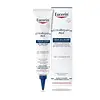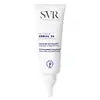What's inside
What's inside
 Key Ingredients
Key Ingredients

 Benefits
Benefits

 Concerns
Concerns

 Ingredients Side-by-side
Ingredients Side-by-side

Water
Skin ConditioningUrea 30%
BufferingOctyldodecanol
EmollientCaprylic/Capric Triglyceride
MaskingSodium Lactate
BufferingDecyl Oleate
EmollientPolyglyceryl-2 Dipolyhydroxystearate
Skin ConditioningArginine Hcl
Skin ConditioningChondrus Crispus Extract
Skin ConditioningCeramide NP
Skin ConditioningCholesterol
EmollientHelianthus Annuus Seed Oil
EmollientAlanine
MaskingCarnitine
CleansingGlycine
BufferingLactic Acid
BufferingSodium PCA
HumectantSodium Chloride
MaskingDecylene Glycol
Skin ConditioningPentylene Glycol
Skin ConditioningWater, Urea 30%, Octyldodecanol, Caprylic/Capric Triglyceride, Sodium Lactate, Decyl Oleate, Polyglyceryl-2 Dipolyhydroxystearate, Arginine Hcl, Chondrus Crispus Extract, Ceramide NP, Cholesterol, Helianthus Annuus Seed Oil, Alanine, Carnitine, Glycine, Lactic Acid, Sodium PCA, Sodium Chloride, Decylene Glycol, Pentylene Glycol
Water
Skin ConditioningUrea
BufferingCocos Nucifera Oil
MaskingGlycerin
HumectantOctyldodecanol
EmollientHydroxyethyl Acrylate/Sodium Acryloyldimethyl Taurate Copolymer
Emulsion StabilisingPanthenol
Skin ConditioningSilica
AbrasivePentylene Glycol
Skin ConditioningGlyceryl Glucoside
HumectantOctyldodecyl Xyloside
EmulsifyingPEG-30 Dipolyhydroxystearate
EmulsifyingTriacetin
AntimicrobialSerine
Masking1,2-Hexanediol
Skin ConditioningCaprylyl Glycol
EmollientSodium Lactate
BufferingPropylene Glycol
HumectantDisodium EDTA
Polysorbate 60
EmulsifyingSorbitan Isostearate
EmulsifyingHistidine
HumectantBacillus Ferment
Skin ConditioningCitric Acid
BufferingPotassium Sorbate
PreservativeWater, Urea, Cocos Nucifera Oil, Glycerin, Octyldodecanol, Hydroxyethyl Acrylate/Sodium Acryloyldimethyl Taurate Copolymer, Panthenol, Silica, Pentylene Glycol, Glyceryl Glucoside, Octyldodecyl Xyloside, PEG-30 Dipolyhydroxystearate, Triacetin, Serine, 1,2-Hexanediol, Caprylyl Glycol, Sodium Lactate, Propylene Glycol, Disodium EDTA, Polysorbate 60, Sorbitan Isostearate, Histidine, Bacillus Ferment, Citric Acid, Potassium Sorbate
 Reviews
Reviews

Alternatives
Ingredients Explained
These ingredients are found in both products.
Ingredients higher up in an ingredient list are typically present in a larger amount.
Octyldodecanol is a fatty alcohol. It is primarily used to enhance the texture of products.
As an emulsifier, Octyldodecanol helps prevent the oils and waters from separating. It also prevents ingredients from creating foam when shaken.
Octyldodecanol is created by reducing fatty acid to an alcohol.
Due to its high molecular weight, it does not get absorbed into the skin.
Learn more about OctyldodecanolPentylene glycol is typically used within a product to thicken it. It also adds a smooth, soft, and moisturizing feel to the product. It is naturally found in plants such as sugar beets.
The hydrophilic trait of Pentylene Glycol makes it a humectant. As a humectant, Pentylene Glycol helps draw moisture from the air to your skin. This can help keep your skin hydrated.
This property also makes Pentylene Glycol a great texture enhancer. It can also help thicken or stabilize a product.
Pentylene Glycol also acts as a mild preservative and helps to keep a product microbe-free.
Some people may experience mild eye and skin irritation from Pentylene Glycol. We always recommend speaking with a professional about using this ingredient in your routine.
Pentylene Glycol has a low molecular weight and is part of the 1,2-glycol family.
Learn more about Pentylene GlycolSodium Lactate is the sodium salt of lactic acid, an AHA. It is a humectant and sometimes used to adjust the pH of a product.
This ingredient is part of our skin's NMF, or natural moisturizing factor. Our NMF is essential for the hydration of our top skin layers and plasticity of skin. NMF also influences our skin's natural acid mantle and pH, which protects our skin from harmful bacteria.
High percentages of Sodium Lactate can have an exfoliating effect.
Fun fact: Sodium Lactate is produced from fermented sugar.
Learn more about Sodium LactateUrea is also called carbamide and is the diamide of carbonic acid. In cosmetics, urea is used to hydrate the skin. It also provides exfoliation in higher concentrations.
As a humectant, urea helps draw moisture from the air and from deep within the skin. This helps hydrate your skin. Studies show urea is an effective moisturizer for dry skin conditions. 40% urea is typical in medications for treating eczema and other skin conditions.
Urea has the strongest exfoliation effect in concentrations higher than 10%. It is a keratolytic agent, meaning it breaks down the keratin protein in the top layer of skin. This helps remove dead skin cells and flaking skin.
In medicine, urea has been shown to help increase the potency of other ingredients, such as fungal treatments.
Humans and animals use urea to metabolize nitrogen-containing compounds. Urea is highly soluble in water. Once dissolved, it is neither acidic nor alkaline.
Learn more about UreaWater. It's the most common cosmetic ingredient of all. You'll usually see it at the top of ingredient lists, meaning that it makes up the largest part of the product.
So why is it so popular? Water most often acts as a solvent - this means that it helps dissolve other ingredients into the formulation.
You'll also recognize water as that liquid we all need to stay alive. If you see this, drink a glass of water. Stay hydrated!
Learn more about Water